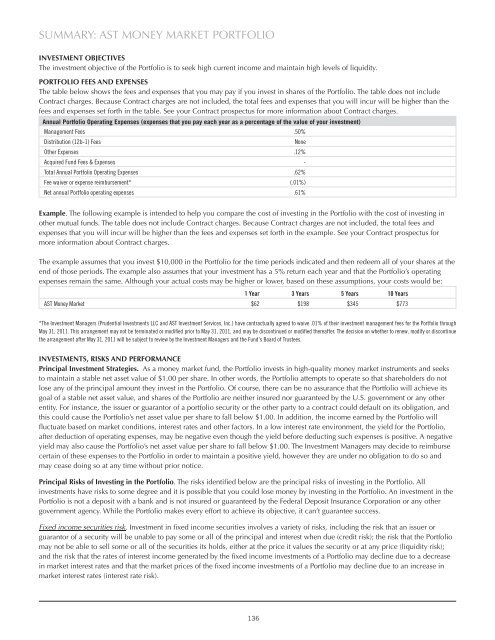Advanced Series Trust AST Academic Strategies Asset ... - Prudential
Advanced Series Trust AST Academic Strategies Asset ... - Prudential
Advanced Series Trust AST Academic Strategies Asset ... - Prudential
You also want an ePaper? Increase the reach of your titles
YUMPU automatically turns print PDFs into web optimized ePapers that Google loves.
SUMMARY: <strong>AST</strong> MONEY MARKET PORTFOLIO<br />
INVESTMENT OBJECTIVES<br />
The investment objective of the Portfolio is to seek high current income and maintain high levels of liquidity.<br />
PORTFOLIO FEES AND EXPENSES<br />
The table below shows the fees and expenses that you may pay if you invest in shares of the Portfolio. The table does not include<br />
Contract charges. Because Contract charges are not included, the total fees and expenses that you will incur will be higher than the<br />
fees and expenses set forth in the table. See your Contract prospectus for more information about Contract charges.<br />
Annual Portfolio Operating Expenses (expenses that you pay each year as a percentage of the value of your investment)<br />
Management Fees .50%<br />
Distribution (12b-1) Fees<br />
Other Expenses .12%<br />
Acquired Fund Fees & Expenses -<br />
Total Annual Portfolio Operating Expenses .62%<br />
Fee waiver or expense reimbursement* (.01%)<br />
Net annual Portfolio operating expenses .61%<br />
None<br />
Example. The following example is intended to help you compare the cost of investing in the Portfolio with the cost of investing in<br />
other mutual funds. The table does not include Contract charges. Because Contract charges are not included, the total fees and<br />
expenses that you will incur will be higher than the fees and expenses set forth in the example. See your Contract prospectus for<br />
more information about Contract charges.<br />
The example assumes that you invest $10,000 in the Portfolio for the time periods indicated and then redeem all of your shares at the<br />
end of those periods. The example also assumes that your investment has a 5% return each year and that the Portfolio’s operating<br />
expenses remain the same. Although your actual costs may be higher or lower, based on these assumptions, your costs would be:<br />
1 Year 3 Years 5 Years 10 Years<br />
<strong>AST</strong> Money Market $62 $198 $345 $773<br />
*The Investment Managers (<strong>Prudential</strong> Investments LLC and <strong>AST</strong> Investment Services, Inc.) have contractually agreed to waive .01% of their investment management fees for the Portfolio through<br />
May 31, 2011. This arrangement may not be terminated or modified prior to May 31, 2011, and may be discontinued or modified thereafter. The decision on whether to renew, modify or discontinue<br />
the arrangement after May 31, 2011 will be subject to review by the Investment Managers and the Fund's Board of <strong>Trust</strong>ees.<br />
INVESTMENTS, RISKS AND PERFORMANCE<br />
Principal Investment <strong>Strategies</strong>. As a money market fund, the Portfolio invests in high-quality money market instruments and seeks<br />
to maintain a stable net asset value of $1.00 per share. In other words, the Portfolio attempts to operate so that shareholders do not<br />
lose any of the principal amount they invest in the Portfolio. Of course, there can be no assurance that the Portfolio will achieve its<br />
goal of a stable net asset value, and shares of the Portfolio are neither insured nor guaranteed by the U.S. government or any other<br />
entity. For instance, the issuer or guarantor of a portfolio security or the other party to a contract could default on its obligation, and<br />
this could cause the Portfolio’s net asset value per share to fall below $1.00. In addition, the income earned by the Portfolio will<br />
fluctuate based on market conditions, interest rates and other factors. In a low interest rate environment, the yield for the Portfolio,<br />
after deduction of operating expenses, may be negative even though the yield before deducting such expenses is positive. A negative<br />
yield may also cause the Portfolio’s net asset value per share to fall below $1.00. The Investment Managers may decide to reimburse<br />
certain of these expenses to the Portfolio in order to maintain a positive yield, however they are under no obligation to do so and<br />
may cease doing so at any time without prior notice.<br />
Principal Risks of Investing in the Portfolio. The risks identified below are the principal risks of investing in the Portfolio. All<br />
investments have risks to some degree and it is possible that you could lose money by investing in the Portfolio. An investment in the<br />
Portfolio is not a deposit with a bank and is not insured or guaranteed by the Federal Deposit Insurance Corporation or any other<br />
government agency. While the Portfolio makes every effort to achieve its objective, it can’t guarantee success.<br />
Fixed income securities risk. Investment in fixed income securities involves a variety of risks, including the risk that an issuer or<br />
guarantor of a security will be unable to pay some or all of the principal and interest when due (credit risk); the risk that the Portfolio<br />
may not be able to sell some or all of the securities its holds, either at the price it values the security or at any price (liquidity risk);<br />
and the risk that the rates of interest income generated by the fixed income investments of a Portfolio may decline due to a decrease<br />
in market interest rates and that the market prices of the fixed income investments of a Portfolio may decline due to an increase in<br />
market interest rates (interest rate risk).<br />
136

















